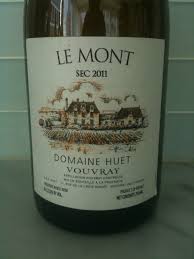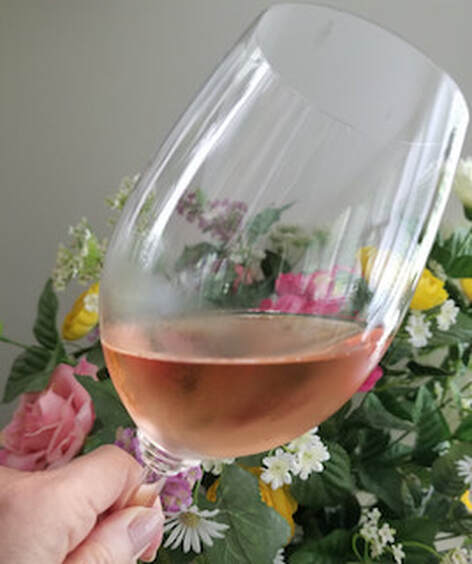|
In between errands yesterday, I was glued to the news with updates on the tragedy that took place in Paris. I was relieved that my niece and cousin were okay, but I still felt unsettled about it all.  At the urging of my friend, I finally relented and agreed to join a few people for a low-key evening. I’m happy that I did. Soft music in the background and wonderful aromas emanating from the kitchen put me in a good mood. I brought homemade whole wheat Cuban bread that was still warm from the oven. My host provided the food and wine.  We drank Santa Barbara Winery 2008 Stolpman Vineyards Santa Ynez Valley Sangiovese. The vineyard is located in Ballard Canyon, which is known for the production of Syrah wines. Although Sangiovese is historically the prime grape of the Chianti region of Italy, the warm climate of Ballard Canyon is nicely suited to growing this grape. The wine was ruby red with heady aromas of cherry, raspberry, a soft floral bouquet and spices. The aromas segued onto the palate with more “jammy” flavors of cherry, red fruit and spice. I wouldn’t normally choose a Sangiovese grape for Thanksgiving, but this particular bottle might be a consideration. It had soft tannins and didn’t challenge the flavors of the food. It is perhaps past peak, but still very drinkable. http://www.stolpmanvineyards.com Have a peaceful Sunday!
Cheers! Penina  It’s a very rainy day here and as much as I would like to snuggle in for the day, I have much to do.  However, before I run off, I’d like to tell you about a wine I had last evening that would pair well with any Thanksgiving feast. We opened a 2009 Ketcham Estate Pinot Noir, Russian River Valley. The color was deep ruby red with delightful aromas of cherries, strawberry, a bit of raspberry and spice. This medium bodied wine offered ripe fruit, black cherry and subtle spice on the palate with a long fruit filled finish. Soft tannins, balanced acidity and smooth texture had us all agreeing that this would make an excellent wine to serve with the assortment of food that usually graces the Thanksgiving table. http://www.ketchamestate.com I’ll return tomorrow with a fantastic side dish recipe!
Happy Wednesday! Cheers! Penina  Sunday was a beautiful day and perfect for outdoor activities. It began with a brisk nature walk and taking in the last of the leaves that were still clinging to the trees. Although I had much to do that required me being indoors, I found an abundance of reasons to keep me outside.  As the sun began to set, I turned my thoughts to creating a seasonal dinner for my friend and I. It was too late to start making bread and soup, so I went “simple”. I baked acorn squash with cinnamon and maple syrup; roasted brussel sprouts in olive oil and tossed them with toasted almonds. I then seared sea scallops with capers and shallots. The whole dinner took about 30 minutes to prepare!  We opened a 2014 J. Lohr Riverstone Chardonnay from Arroyo Seco Monterey, Central Coast, CA that complemented the meal beautifully. I reviewed the 2013 back in June and this vintage was just as good. The color was pale yellow with aromas of peach, strawberry, honeysuckle and nuts. The aromas carried over onto the palate with a hint of oak and a smooth buttery feel on the finish. I have a few more bottles, one of which is already in the refrigerator on standby! You can’t go wrong with this chardonnay or the price. It retails for around $14.00. http://www.jlohr.com I’m off to the city on an adventure!
Happy Monday! Cheers! Penina  Friday turned into a serendipity day…my favorite kind! After meeting with a client in the morning, I was all set to work on some projects. However, a phone call from a friend veered me in another direction and I was off on an adventure that included a beautiful fall ride, lunch and wine.  We each had a glass of 2012 Navarro Vineyards “Mendocino” Chardonnay with our lunch. The color was pale straw with pear, honeysuckle, and a hint of citrus on the nose. The palate offered pear, oak, apple and lemon. The wine was crisp with a medium finish and paired nicely with the crab cakes and salad. http://www.navarrowine.com  As I was finally making my way home, another friend called to invite me over for a quick drink of Zodiac Vodka. Trust me…I only had a sip or two, but the vodka was good! It seemed to have more “perfume” on the palate than I recall from my last review, but it was delicious and it is quite different from most vodka that I’ve tasted. I reviewed it on Day 132, 11/11/2014. Here is the review from one year ago: Day 132 on 11/11/2014 The name of the vodka is Zodiac…American-Made in Idaho. It is one of the better potato vodkas that I have had! They originally launched 15 years ago and then re-launched this past October. The vodka is made with regionally sourced potatoes and water from the Snake River Aquifer that runs beneath the distillery. It had a slightly sweet and much cleaner smell than grain vodka. The sweetness extended into the taste, which again, was clean and very smooth. It had a very pleasant aftertaste. Zodiac is also 100% gluten-free! I’m definitely going to add Zodiac to my freezer collection! http://zodiacspirits.com Happy Saturday!
Cheers! Penina It was a long but productive Wednesday. I managed to squeeze in a photo shoot, meet with clients and write a story. By the time I got home it was dark…and not even 6:00 pm yet! Ugh!  While waiting for my dinner guest to arrive, I opened a bottle of 2011 D'Isanto & D'Isanto I Balzini Black Label Colli della Toscana Centrale IGT. After having tried and reviewed their White and Red Label, I was anxious to finally taste the Black Label. Made with a blend of Cabernet Sauvignon and Merlot, this bold wine was the color of deep purple. Aromas of dark berries, spice and cocoa were present. A quick sip and swirl upon opening, told me this was going to be a treat. The wine had a rich mouthfeel with concentrated berries, dark cherry, plum, licorice and dark chocolate on the palate. As the wine opened over the course of the evening the flavors became more intense. The tannins were soft and the finish was long with cherry and pepper lingering. I think the Black Label is my favorite so far! You can read more about these wines on my previous posts: Day 347 9/22/15 and Day 230 3/19/15. http://www.ibalzini.it  In anticipation of traveling a lot over the next few months, I finally got my flu shot this week. If you plan to travel by plane, subway, train, etc., I would suggest protecting yourself, by getting a flu shot soon! Happy Thursday! Cheers! Penina  The World Series is over and even though I’m a Mets fan, the KC Royals deserved to win. It was enjoyable watching a few of the games with friends, drinking nice wine and munching on food. However, last night I looked forward to crawling into bed before midnight!  As the holiday season approaches, everyone is starting to plan their menus and deciding what wine to serve. Or, if an invited guest, what house gift to bring. Not everyone cooks the “traditional” turkey for Thanksgiving. I have made poached salmon in addition to turkey on many a Thanksgiving holiday. And most of the side dishes that I make go well with both entrees. There are many wines to choose from that will pair well with a meat or meatless Thanksgiving dinner such as sparkling wines that can be elegant and versatile. When choosing whites you might want to go with a wine that has well-balanced acidity such as Riesling, Sauvignon Blanc and Albarino. With red wines, the focus should be on soft tannins so it doesn’t compete with the flavor of the food such as Zinfandel, Syrah, Pinot Noir and Rosés. All these wines make a nice complement to the meal and there are many more grapes to choose from. There is no right or wrong choice, it is truly a personal preference. I will explore more wines for the holidays in the next week or so.  The other evening I had a lovely 2010 Hooker “Blind Side” California Zinfandel. It was easy to drink and I wouldn’t hesitate to serve it with a holiday meal. It is a blend of 79% Zinfandel, 20% Petite Sirah and 1% Merlot. The aromas of berries, spice, caramel and raspberry gave way to cranberry, vanilla, pepper and tobacco on the palate. The finish was long and earthy with spice and pepper lingering. I was imagining how well it would complement my Ice Cream Pumpkin Pie. http://www.lawerfamilywines.com An interesting note about the name of the wine: Betsy Lawer’s father and husband both played the “hooker” position on rugby teams. Her father played for Stanford and her husband played for Duke….hence the “Hooker” label. Have a great Tuesday!
Cheers! Penina  It’s another beautiful day and I’m looking forward to a weekend filled with the World Series, scenic walks and wine tasting.  In some of my recent posts I talked about wines from Portugal. I’d like to mention another winery, Caves Campelo in Barcelos. It is located in the north of Portugal in the Vinho Verde wine region. Although it was established in 1951, there are records dating back to 1923. The company was acquired by José Carlos Lima & Sons in 2007. Caves Campelo offers a wide range of wines such as Vinho Verde, Douro, Dão and Porto wines. I met with Sophia Costa, their export manager who guided me through a tasting of a few of the Vinho Verde wines. We began with Miranda 2014, a ROSÉ wine that was soft pink. It had lovely aromas of fruit and flowers with fresh fruit on the palate. It had a nice mouth feel and was well balanced. The Campelo Adamado 2014 was straw colored with green hues. It had citrus and apples on the nose, with lemon and pear on the palate. The finish was short. The Tapada do Marques Arinto 2014 made with 100% Arinto grape, was “driven” on the nose, but subtle with citrus and floral undertones on the palate. It was quite refreshing. Visit Caves Campelo website for an extensive list of all their wines. www.campelo.pt Have a great start to the weekend!
Happy Friday! Cheers! Penina  The World Series Game One went 14 innings last night with KC finally ending it with a win. In between sipping wine and watching the game, it turned into a very late night!  My post about Château Haut-Brion yesterday had quite a few people guessing as to which vintage was opened. Some of you thought both years were opened, while others seemed to lean towards the 61’. As you can see, the 1994 Château Haut-Brion was the chosen vintage. After decanting the wine, we took a quick taste before allowing it to open. The color was crimson with a powerful earthiness on the nose that gave way to subtler undertones of fruit and leather. It needed time to open up. After one hour, the bouquet was more floral, although a “musty” aroma and taste lingered. Dried herbs, spice and dark fruit began to emerge as the evening wore on. It didn’t have the depth of flavor that I hoped for, but it was smooth, subtle and enjoyable to the last drop! www.haut-brion.com It’s going to be a stormy day and a good time to attend to a few indoor projects.
Happy Wednesday! Cheers! Penina  We went from several days of warm weather to waking up to cold temperatures this morning. Brrr…. The heat was turned back on and the windows were closed again.  To celebrate the “warmer” temperatures the other evening, a friend and I dined on mussels, pasta and swordfish. The balmy weather seemed to warrant a more “summery” type menu. Our choice of wine reflected that as well. We opened a 2011 Domaine Huet Vouvray Sec Le Mont Chenin Blanc to complement the meal. The wine is produced in the Vouvray district of the Loire valley. This was a lovely dry Chenin Blanc with a golden color. The aromas of honeysuckle, green tea and floral notes were present. The palate offered soft fruits, pear, lemon and medium acidity. The finish was long with hints of apple lingering. http://www.domainehuet.com I have a feeling that I will be drinking heartier wines this weekend!
Happy Friday! Cheers! Penina  On Tuesday I attended The Grandi Marchi Experience in NYC, a guided tasting of Italy’s top terroirs. The event was held at Del Posto, another amazing creation of Mario Batali located in the now trendy meatpacking district. Gloria Maoroti Frazee, the Director of Video & Education, Wine Spectator, moderated the event. Not only did we taste the wines, but also had the pleasure of hearing from the principles of each winery as we swirled and sipped. Each spokesperson had a wonderful story to tell. We heard about their fathers, grandfathers and great-grandfathers who’s input helped to make the wines what they are today. The Institute of Fine Italian Wines-Premium brands is comprised of nineteen important Italian wineries with the objective to promote culture and commercialism of high end Italian wine to world markets. The wineries are defined by high standards of product and brand image at national and international levels.  Of the nineteen wineries that make up the institute, fifteen wineries were present yesterday. We tasted 15 wines from Lombardy, Tuscany, Marches, Piedmont, Sardinia, Sicily, Campania, Puglia, Umbria and Veneto. We started with a refreshing 2006 Cuvée Annamarie Clementi and ended with a 2008 Ben Ryé Passito di Pantelleria D.O.C Limited Edition dessert wine. In between we tasted two more whites and eleven reds from producers such as Gaja, Tenuta San Guido, Antinori, Masi, Rivera and Pio Cesare. I will elaborate on some of the wines that I tasted in tomorrow’s post.
Have a great Wednesday! Cheers! Penina |
Categories
All
|

 RSS Feed
RSS Feed